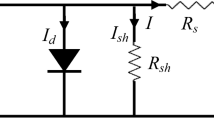Abstract
Results from experimental studies of a solar cogeneration system with linear photovoltaic modules of a fundamentally new design are presented. The Ʌ-shaped frontal walls are installed face-to-face at an angle to each other and mutually shield their own thermal radiation, which decreases the radiation heat losses by 27% compared with linear photovoltaic modules of the known designs. The photocurrent generated by cooled solar cells is directed to a system for charging chemical batteries and the thermal energy released is transmitted to the unconsumed intermediate heat-transfer fluid and then, through the surface of coil pipes of counter-current heat exchangers, to the consumed process water of the outer circulation circuit. The further transportation of thermal energy to the storage system occurs by natural circulation of the consumed process water through the temperature gradient formed by the control system over the height between the heat source, the heat exchanger, and the heat receiver, an insulated container (a heat accumulator). For the first time, efficient controlled transportation of heat has been implemented without using a circulation pump owing to the excess thermal energy released during the conversion of solar energy by the solar cells and a photo-selective film installed in the focal spot of the optical concentrator. Thus, a possibility of increasing the temperature of the heat-transfer fluids at the cogeneration system outlet has been offered. A two-circuit circulation system allows for separation of unconsumed heat-transfer fluids (antifreezing solutions) and the consumed fluid (the process water) by the pressure in the channels and installation of a linear counter-current heat exchanger that performs the functions of a supporting platform’s mechanical axis along the rotational axis of the optical concentrator. The system uses a dual-axis solar tracking concentrating system comprised of flat mirrors installed at an angle to the horizon. The arrangement of the Ʌ-shaped photovoltaic modules on the supporting framework in series along the heat-transfer-fluid path allows for a reduction in the overall dimensions of the channels, an increase in the total efficiency of the solar cells, and simplification of the encapsulation technology. A method for calculating the output of the cogeneration plant is provided. The method is based on the experimentally measured characteristics of silicon solar cells and heat losses in the channels of the linear photovoltaic modules.






Similar content being viewed by others
REFERENCES
T. T. Chow, “A review on photovoltaic/thermal hybrid solar technology,” Appl. Energy 87, 365–379 (2010). https://doi.org/10.1016/j.apenergy.2009.06.037
J. A. Duffie and W. A. Beckman, Solar Engineering of Thermal Processes, 3rd ed. (Wiley, Hoboken, NJ, 2006).
A. Kribus, D. Raftori, G. Mittelman, A. Hirshfeld, and A. Dayan, “A miniature concentrating photovoltaic end thermal system,” Energy Convers. Manage. 47, 3582–3590 (2006). https://doi.org/10.1016/j.enconman.2006.01.013
J. S. Coventry, “Performance of a concentrating photovoltaic/thermal solar collector,” Sol. Energy 78, 211–222 (2005). https://doi.org/10.1016/j.solener.2004.03.014
Cogenra’s ’Hybrid’ Solar System Captures 80% of the Sun’s 111. https://www.treehugger.com › renewable-energy. Accessed May 24, 2019.
A. G. Nesterenkov, P. A. Nesterenkov, and L. A. Nesterenkova, “The method of converting solar radiation into electrical and thermal energy and the plant for implementing the method,” RK Patent No. 30003, Baza Patent Kaz. (2015).
P. A. Nesterenkov, A. G. Nesterenkov, and L. A. Nesterenkova, “Fundamentals of designing hybrid concentrator solar systems,” in Proc. 12th Int. Conf. on Concentrator Photovoltaics (CPV-12), Freiburg, Germany, April 25–27, 2016 (American Inst. of Physics, 2016).
https://www.alanod.com. Accessed February 25, 2019.
L. C. Chea, H. Hakansson, and B. Karlsson, “Performance evaluation of new two axes tracking PV-thermal concentrator,” Am. J. Civ. Eng. Archit. 7, 1485–1493 (2013). https://doi.org/10.17265/1934-7359/2013.12.002
Almeco-Tinox Solar. Tinox Energy. http://www.almecogroup.com/en/pagina/16-solar
Z. S. Judkins, K. W. Johnston, C. Almy, R. J. Linderman, B. Wares, N. A. Barton, M. Dawson, and J. Peurach., Performance Results of a Low-Concentration Photovoltaic System Based on High Efficiency Back Contact Cells, SunPower Corporation Report (2010).
M. A. Mikheev and I. M. Mikheeva, Fundamentals of Heat Transfer (Energiya, Moscow, 1977) [in Russian].
V. P. Isachenko, V. A. Osipova, and A. S. Sukomel, Heat Transfer (Energiya, Moscow, 1969; Mir, Moscow, 1969).
P. A. Nesterenkov, L. A. Nesterenkova, and A. G. Nesterenkov, “Cogeneration solar systems with concentrators of solar radiation,” in Handbook of Research on Renewable Energy and Electric Resources for Sustainable Rural Development (IGI Global, Hershey, PA, 2018), pp. 230–254. https://doi.org/10.4018/978-1-5225-3867-7.ch010
V. A. Osipova, Experimental Investigation of Heat Exchange Processes: Study Aid (Energiya, Moscow, 1979) [in Russian].
A. G. Nesterenkov, P. A. Nesterenkov, and L. A. Nesterenkova, “A method of converting solar radiation and a cogeneration plant for implementing the method,” RK Patent No. 33513, Baza Pat. Kaz. (2018).
P. A. Nesterenkov and V. V. Kharchenko, “Thermo physical principles of cogeneration technology with concentration of solar radiation,” in Proc. 2nd Int. Conf. on Intelligent Computing & Optimization (ICO 2019), Koh Samui, Thailand, Oct. 3–4,2019 (Springer-Verlag, Cham, 2019), Vol. 1, pp. 117–128.
A. G. Blokh, Yu. A. Zhuravlev, and L. N. Ryzhkov, Radiative Heat Transfer: Handbook (Energoatomizdat, Moscow, 1991) [in Russian].
USSR Climate Handbook, Series 3: Multi-Year Data, Vol. 1–6, Iss. 18: Kazakh SSR, (Gidrometeoizdat, Moscow, 1989), Book 1 [in Russian].
Water Consumption per Person per Day. https://hitropop. com/voda/normy/potreblenie-v-sutki.html
Thermophysical Properties of Substances: Handbook, Ed. by R. B. Vargaftik (Gosenergoizdat, Moscow, 1956) [in Russian].
Tariffs on Renewable Energy Sources. http://astanasolar. kz/ru/news/utverzhdeny-tarify-na-vozobnovlyaemye-istochniki-energii
Author information
Authors and Affiliations
Corresponding authors
Additional information
Translated by O. Lotova
Rights and permissions
About this article
Cite this article
Nesterenkov, P.A., Nesterenkov, A.G. & Temirbekov, A.N. Cogeneration Plants with Solar Radiation Concentrators. Therm. Eng. 67, 706–714 (2020). https://doi.org/10.1134/S0040601520100079
Received:
Revised:
Accepted:
Published:
Issue Date:
DOI: https://doi.org/10.1134/S0040601520100079




